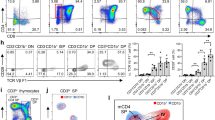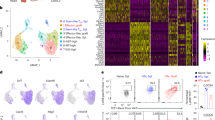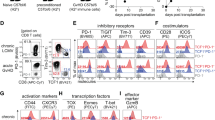Abstract
Recent thymic emigrants (RTEs) are antigenically naive T cells that have recently completed intrathymic maturation and have emigrated from the thymus to the periphery. RTEs are clinically and immunologically important as they are essential for maintaining peripheral T cells in sufficient numbers in order to recognize, by their αβT-cell receptors (TCRs), a diverse array of foreign peptide antigens. However, RTE frequency and function has been poorly understood because of a lack of surface markers to distinguish them from older non-RTE naive T cells. This review summarizes the biology of the intrathymic generation and function of RTEs, including the recent identification of protein tyrosine kinase 7 (PTK7) as a novel marker for human RTEs of the CD4 (helper) T-cell lineage. PTK7+ RTEs in adults have a reduced capacity for activation-induced proliferation and cytokine production (interleukin-2 and interferon-γ) than older PTK7− naive CD4 T cells. Importantly, this immaturity in CD4 RTE effector function may contribute to the reduced adaptive immune responses observed in situations in which CD4 RTEs predominate, including the fetus, neonate and young infant, and following immune reconstitution, such as post-hematopoietic stem cell transplant. The ability to identify viable CD4+ RTEs based on PTK7 surface staining may be particularly useful in the infant for better defining the impact of nutritional and environmental factors on thymic output, peripheral T-cell function and adaptive immune responses to vaccination and infection.
This is a preview of subscription content, access via your institution
Access options
Subscribe to this journal
Receive 12 print issues and online access
$259.00 per year
only $21.58 per issue
Buy this article
- Purchase on Springer Link
- Instant access to full article PDF
Prices may be subject to local taxes which are calculated during checkout





Similar content being viewed by others
References
Zhu J, Yamane H, Paul WE . Differentiation of effector CD4 T cell populations. Annu Rev Immunol 2010; 28: 445–489.
Wan YY . Multi-tasking of helper T cells. Immunology 2010; 130: 166–171.
Eyerich S, Eyerich K, Pennino D, Carbone T, Nasorri F, Pallotta S et al. Th22 cells represent a distinct human T cell subset involved in epidermal immunity and remodeling. J Clin Invest 2009; 119: 3573–3585.
Livingstone AM, Wilson EB, Ontiveros F, Wang JC . Unravelling the mechanisms of help for CD8+ T cell responses. Immunol Res 2009; 45: 209–217.
Sakaguchi S, Miyara M, Costantino CM, Hafler DA . FOXP3+ regulatory T cells in the human immune system. Nat Rev Immunol 2010; 10: 490–500.
Lewis DB, Wilson CB . Developmental immunology and role of host defenses in fetal and neonatal susceptibility to infection. In: Remington JS, Klein JO, Wilson CB, Nizet V, Maldonado YA (eds). Infectious Diseases of the Fetus and Newborn Infant, 7th edn. Elsevier (Saunders): Philadelphia, 2010, pp 80–191.
Robins HS, Campregher PV, Srivastava SK, Wacher A, Turtle CJ, Kahsai O et al. Comprehensive assessment of T-cell receptor beta-chain diversity in alphabeta T cells. Blood 2009; 114: 4099–4107.
Arstila TP, Casrouge A, Baron V, Even J, Kanellopoulos J, Kourilsky P . A direct estimate of the human alphabeta T cell receptor diversity. Science 1999; 286: 958–961.
Six EM, Bonhomme D, Monteiro M, Beldjord K, Jurkowska M, Cordier-Garcia C et al. A human postnatal lymphoid progenitor capable of circulating and seeding the thymus. J Exp Med 2007; 204: 3085–3093.
Dik WA, Pike-Overzet K, Weerkamp F, de Ridder D, de Haas EF, Baert MR et al. New insights on human T cell development by quantitative T cell receptor gene rearrangement studies and gene expression profiling. J Exp Med 2005; 201: 1715–1723.
Sauce D, Larsen M, Fastenackels S, Duperrier A, Keller M, Grubeck-Loebenstein B et al. Evidence of premature immune aging in patients thymectomized during early childhood. J Clin Invest 2009; 119: 3070–3078.
Hosseinzadeh H, Goldschneider I . Recent thymic emigrants in the rat express a unique antigenic phenotype and undergo post-thymic maturation in peripheral lymphoid tissues. J Immunol 1993; 150: 1670–1679.
Hassan J, Reen DJ . IL-7 and homeostasis of recent thymic emigrants. Trends Immunol 2002; 23: 126–127.
Jimenez E, Sacedon R, Vicente A, Hernandez-Lopez C, Zapata AG, Varas A . Rat peripheral CD4+CD8+ T lymphocytes are partially immunocompetent thymus-derived cells that undergo post-thymic maturation to become functionally mature CD4+ T lymphocytes. J Immunol 2002; 168: 5005–5013.
Boursalian TE, Golob J, Soper DM, Cooper CJ, Fink PJ . Continued maturation of thymic emigrants in the periphery. Nat Immunol 2004; 5: 418–425.
Ye P, Kirschner DE . Reevaluation of T cell receptor excision circles as a measure of human recent thymic emigrants. J Immunol 2002; 168: 4968–4979.
Douek DC, McFarland RD, Keiser PH, Gage EA, Massey JM, Haynes BF et al. Changes in thymic function with age and during the treatment of HIV infection. Nature 1998; 396: 690–695.
Okamoto Y, Douek DC, McFarland RD, Koup RA . Effects of exogenous interleukin-7 on human thymus function. Blood 2002; 99: 2851–2858.
McFarland RD, Douek DC, Koup RA, Picker LJ . Identification of a human recent thymic emigrant phenotype. Proc Natl Acad Sci USA 2000; 97: 4215–4220.
Shearer WT, Rosenblatt HM, Gelman RS, Oyomopito R, Plaeger S, Stiehm ER et al. Lymphocyte subsets in healthy children from birth through 18 years of age: the Pediatric AIDS Clinical Trials Group P1009 study. J Allergy Clin Immunol 2003; 112: 973–980.
Bisset LR, Lung TL, Kaelin M, Ludwig E, Dubs RW . Reference values for peripheral blood lymphocyte phenotypes applicable to the healthy adult population in Switzerland. Eur J Haematol 2004; 72: 203–212.
Spits H . Development of alpha/beta T cells in the human thymus. Nat Rev Immunol 2002; 2: 760–772.
Bains I, Antia R, Callard R, Yates AJ . Quantifying the development of the peripheral naive CD4+ T-cell pool in humans. Blood 2009; 113: 5480–5487.
Sportes C, Hakim FT, Memon SA, Zhang H, Chua KS, Brown MR et al. Administration of rhIL-7 in humans increases in vivo TCR repertoire diversity by preferential expansion of naive T cell subsets. J Exp Med 2008; 205: 1701–1714.
Endl E, Hollmann C, Gerdes J . Antibodies against the Ki-67 protein: assessment of the growth fraction and tools for cell cycle analysis. Methods Cell Biol 2001; 63: 399–418.
Hellerstein MK, Hoh RA, Hanley MB, Cesar D, Lee D, Neese RA et al. Subpopulations of long-lived and short-lived T cells in advanced HIV-1 infection. J Clin Invest 2003; 112: 956–966.
Hazenberg MD, Borghans JA, de Boer RJ, Miedema F . Thymic output: a bad TREC record. Nat Immunol 2003; 4: 97–99.
Sasson SC, Zaunders JJ, Kelleher AD . The IL-7/IL-7 receptor axis: understanding its central role in T-cell homeostasis and the challenges facing its utilization as a novel therapy. Curr Drug Targets 2006; 7: 1571–1582.
Schonland SO, Zimmer JK, Lopez-Benitez CM, Widmann T, Ramin KD, Goronzy JJ et al. Homeostatic control of T-cell generation in neonates. Blood 2003; 102: 1428–1434.
Szabolcs P, Park KD, Reese M, Marti L, Broadwater G, Kurtzberg J . Coexistent naive phenotype and higher cycling rate of cord blood T cells as compared to adult peripheral blood. Exp Hematol 2003; 31: 708–714.
Dardalhon V, Jaleco S, Kinet S, Herpers B, Steinberg M, Ferrand C et al. IL-7 differentially regulates cell cycle progression and HIV-1-based vector infection in neonatal and adult CD4+ T cells. Proc Natl Acad Sci USA 2001; 98: 9277–9282.
Hassan J, Reen DJ . Human recent thymic emigrants—identification, expansion, and survival characteristics. J Immunol 2001; 167: 1970–1976.
Okazaki H, Ito M, Sudo T, Hattori M, Kano S, Katsura Y et al. IL-7 promotes thymocyte proliferation and maintains immunocompetent thymocytes bearing alpha beta or gamma delta T-cell receptors in vitro: synergism with IL-2. J Immunol 1989; 143: 2917–2922.
Ribeiro RM, Perelson AS . Determining thymic output quantitatively: using models to interpret experimental T-cell receptor excision circle (TREC) data. Immunol Rev 2007; 216: 21–34.
Jamieson BD, Douek DC, Killian S, Hultin LE, Scripture-Adams DD, Giorgi JV et al. Generation of functional thymocytes in the human adult. Immunity 1999; 10: 569–575.
Douek DC, Picker LJ, Koup RA . T cell dynamics in HIV-1 infection. Annu Rev Immunol 2003; 21: 265–304.
Hazenberg MD, Otto SA, Cohen Stuart JW, Verschuren MC, Borleffs JC, Boucher CA et al. Increased cell division but not thymic dysfunction rapidly affects the T-cell receptor excision circle content of the naive T cell population in HIV-1 infection. Nat Med 2000; 6: 1036–1042.
Douek DC, Vescio RA, Betts MR, Brenchley JM, Hill BJ, Zhang L et al. Assessment of thymic output in adults after haematopoietic stem-cell transplantation and prediction of T-cell reconstitution. Lancet 2000; 355: 1875–1881.
Napolitano LA, Schmidt D, Gotway MB, Ameli N, Filbert EL, Ng MM et al. Growth hormone enhances thymic function in HIV-1-infected adults. J Clin Invest 2008; 118: 1085–1098.
Seggewiss R, Lore K, Guenaga FJ, Pittaluga S, Mattapallil J, Chow CK et al. Keratinocyte growth factor augments immune reconstitution after autologous hematopoietic progenitor cell transplantation in rhesus macaques. Blood 2007; 110: 441–449.
Sempowski G, Thomasch J, Gooding M, Hale L, Edwards L, Ciafaloni E et al. Effect of thymectomy on human peripheral blood T cell pools in myasthenia gravis. J Immunol 2001; 166: 2808–2817.
Halnon NJ, Jamieson B, Plunkett M, Kitchen CM, Pham T, Krogstad P . Thymic function and impaired maintenance of peripheral T cell populations in children with congenital heart disease and surgical thymectomy. Pediatr Res 2005; 57: 42–48.
Weerkamp F, Baert MR, Brugman MH, Dik WA, de Haas EF, Visser TP et al. Human thymus contains multipotent progenitors with T/B lymphoid, myeloid, and erythroid lineage potential. Blood 2006; 107: 3131–3137.
Hale LP . Histologic and molecular assessment of human thymus. Ann Diagn Pathol 2004; 8: 50–60.
Blume-Jensen P, Hunter T . Oncogenic kinase signalling. Nature 2001; 411: 355–365.
Haines CJ, Giffon TD, Lu LS, Lu X, Tessier-Lavigne M, Ross DT et al. Human CD4+ T cell recent thymic emigrants are identified by protein tyrosine kinase 7 and have reduced immune function. J Exp Med 2009; 206: 275–285.
Lu X, Borchers AG, Jolicoeur C, Rayburn H, Baker JC, Tessier-Lavigne M . PTK7/CCK-4 is a novel regulator of planar cell polarity in vertebrates. Nature 2004; 430: 93–98.
Beverley PC . Kinetics and clonality of immunological memory in humans. Semin Immunol 2004; 16: 315–321.
Weerkamp F, de Haas EF, Naber BA, Comans-Bitter WM, Bogers AJ, van Dongen JJ et al. Age-related changes in the cellular composition of the thymus in children. J Allergy Clin Immunol 2005; 115: 834–840.
Kimmig S, Przybylski GK, Schmidt CA, Laurisch K, Mowes B, Radbruch A et al. Two subsets of naive T helper cells with distinct T cell receptor excision circle content in human adult peripheral blood. J Exp Med 2002; 195: 789–794.
Hale JS, Boursalian TE, Turk GL, Fink PJ . Thymic output in aged mice. Proc Natl Acad Sci USA 2006; 103: 8447–8452.
Fry TJ, Mackall CL . What limits immune reconstitution in HIV infection? Divergent tools converge on thymic function. AIDS 2001; 15: 1881–1882.
Marino JH, Tan C, Taylor AA, Bentley C, Van De Wiele CJ, Ranne R et al. Differential IL-7 responses in developing human thymocytes. Hum Immunol 2010; 71: 329–333.
Randolph DA, Lewis DB . Transient deficiencies of T-cell-mediated immunity in the neonate. Adv Exp Med Biol 2006; 582: 55–69.
Smith S, Jacobs RF, Wilson CB . Immunobiology of childhood tuberculosis: a window on the ontogeny of cellular immunity. J Pediatr 1997; 131: 16–26.
Liebhaber M, Lewiston NJ, Asquith MT, Olds-Arroyo L, Sunshine P . Alterations of lymphocytes and of antibody content of human milk after processing. J Pediatr 1977; 91: 897–900.
Moore SE, Collinson AC, Tamba N’Gom P, Aspinall R, Prentice AM . Early immunological development and mortality from infectious disease in later life. Proc Nutr Soc 2006; 65: 311–318.
Burke BA, Good RA . Pneumocystis carinii infection. Medicine (Baltimore) 1973; 52: 23–51.
Collinson AC, Moore SE, Cole TJ, Prentice AM . Birth season and environmental influences on patterns of thymic growth in rural Gambian infants. Acta Paediatr 2003; 92: 1014–1020.
Ngom PT, Collinson AC, Pido-Lopez J, Henson SM, Prentice AM, Aspinall R . Improved thymic function in exclusively breastfed infants is associated with higher interleukin 7 concentrations in their mothers’ breast milk. Am J Clin Nutr 2004; 80: 722–728.
Hasselbalch H, Engelmann MD, Ersboll AK, Jeppesen DL, Fleischer-Michaelsen K . Breast-feeding influences thymic size in late infancy. Eur J Pediatr 1999; 158: 964–967.
Jung JW, Ji AR, Lee J, Kim UJ, Lee ST . Organization of the human PTK7 gene encoding a receptor protein tyrosine kinase-like molecule and alternative splicing of its mRNA. Biochim Biophys Acta 2002; 1579: 153–163.
Jung JW, Shin WS, Song J, Lee ST . Cloning and characterization of the full-length mouse Ptk7 cDNA encoding a defective receptor protein tyrosine kinase. Gene 2004; 328: 75–84.
Prebet T, Lhoumeau AC, Arnoulet C, Aulas A, Marchetto S, Audebert S et al. The cell polarity PTK7 receptor acts as a modulator of the chemotherapeutic response in acute myeloid leukemia and impairs clinical outcome. Blood 2010; 116: 2315–2323.
Hazenberg MD, Verschuren MC, Hamann D, Miedema F, van Dongen JJ . T cell receptor excision circles as markers for recent thymic emigrants: basic aspects, technical approach, and guidelines for interpretation. J Mol Med 2001; 79: 631–640.
Acknowledgements
We thank Li-Sheng Lu, Thierry Giffon, Kira Dionis, Xiao-Wei Lu and Marc Tessier-Lavigne for their many contributions to the PTK7 RTE project, and David Hong for reading the manuscript. This work was supported in part by National Institutes of Health/NIAID grants R01 AI-083757 and R56 AI-083757 (to DBL).
Author information
Authors and Affiliations
Corresponding author
Ethics declarations
Competing interests
DR has equity/stock options with Clariant. The remaining authors have declared no financial interest.
Rights and permissions
About this article
Cite this article
Lewis, D., Haines, C. & Ross, D. Protein tyrosine kinase 7: a novel surface marker for human recent thymic emigrants with potential clinical utility. J Perinatol 31 (Suppl 1), S72–S81 (2011). https://doi.org/10.1038/jp.2010.187
Published:
Issue Date:
DOI: https://doi.org/10.1038/jp.2010.187
Keywords
This article is cited by
-
Investigating Efficacy of Three DNA-Aptamers in Targeted Plasmid Delivery to Human Prostate Cancer Cell Lines
Molecular Biotechnology (2023)
-
Post-thymic maturation: young T cells assert their individuality
Nature Reviews Immunology (2011)



